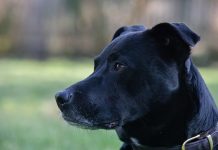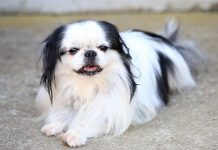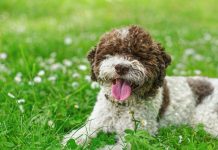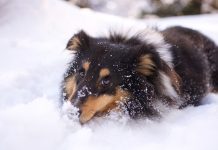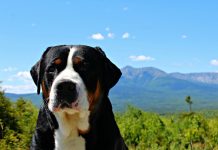History and Origins of the Airedale Terrier Breed

The Airedale Terrier, often referred to as the “King of Terriers,” has a fascinating history rooted in England. Here are the key points about the origins and development of the Airedale Terrier breed:
- Early Roots: The Airedale Terrier originated in the Aire Valley of Yorkshire, England, during the mid-19th century. The breed was developed by crossing various terrier breeds, including the now-extinct Black and Tan Terrier, Otterhound, and possibly the Irish Terrier.
- Purpose and Function: Airedales were initially bred to serve as versatile hunting and working dogs. They were highly valued for their ability to hunt small game, such as rats and otters, as well as larger game like boars and deer. Airedales were also used as effective guard dogs and messengers during wartime.
- Crossbreeding and Development: The development of the Airedale Terrier involved careful crossbreeding to achieve desired traits, including intelligence, courage, endurance, and a non-shedding coat. The breed was recognized by the Kennel Club (UK) in 1886 and by the American Kennel Club (AKC) in 1888.
- Popularity and Role: Airedales gained popularity not only as skilled hunting dogs but also as beloved companions and family pets. Their intelligence and trainability made them suitable for various roles, including police and military work.
Physical Characteristics and Appearance of Airedale Terriers
The Airedale Terrier is a distinctive and striking breed known for its athletic build and wiry coat. Here are the key physical characteristics and appearance traits of Airedale Terriers:
- Size: Airedales are medium to large-sized dogs, with males typically standing 23 to 24 inches (58 to 61 cm) tall at the shoulder and weighing 55 to 65 pounds (25 to 29 kg). Females are slightly smaller, standing 22 to 23 inches (56 to 58 cm) tall and weighing 40 to 55 pounds (18 to 25 kg).
- Build: Airedales have a sturdy and muscular build, with a deep chest and straight back. They exhibit a balanced and well-proportioned appearance, reflecting their agility and athleticism.
- Coat: The Airedale Terrier’s coat is distinctive, being dense, wiry, and weather-resistant. The coat is typically tan with a black saddle (or sometimes grizzle) on the back and sides. Their eyebrows and beard add to their expressive and distinctive look.
- Head and Expression: Airedales have a long, flat skull with a pronounced stop. They have small, dark eyes that convey intelligence and alertness. Their ears are V-shaped and fold slightly forward, giving them an attentive expression.
- Tail: The Airedale’s tail is set high and carried upright. It is customarily docked to a medium length in countries where docking is allowed, although this practice is becoming less common.
- Gait: Airedales move with a purposeful and confident gait, reflecting their keen hunting instincts and energetic nature.
- Expression: Airedales are known for their keen and intelligent expression, combined with an air of confidence and independence.
The Airedale Terrier’s distinctive appearance, coupled with its energetic personality and loyal nature, makes it a beloved breed for families and active individuals alike. They excel in various canine activities, including obedience, agility, and tracking, and thrive on mental and physical stimulation. With proper training and socialization, the Airedale Terrier is a versatile and devoted companion.
Temperament and Personality Traits
- Confident and Assertive: Airedales are confident dogs with a bold and assertive nature. They are known for their independent streak and may exhibit strong-willed behavior.
- Intelligent and Alert: Airedale Terriers are highly intelligent dogs with keen problem-solving abilities. They are alert and attentive, making them excellent watchdogs.
- Energetic and Spirited: Airedales have a lot of energy and require regular exercise to stay happy and healthy. They enjoy outdoor activities and thrive on physical challenges.
- Loyal and Protective: Airedales are loyal to their families and can be protective of their loved ones. They form strong bonds with their owners and are devoted companions.
- Playful and Affectionate: Despite their terrier demeanor, Airedales have a playful and affectionate side. They enjoy interactive games and thrive on positive attention from their family members.
- Social and Outgoing: Airedales are generally sociable dogs that enjoy meeting new people and other dogs. Proper socialization from an early age is essential to prevent aggressive behavior towards unfamiliar individuals or animals.
- Curious and Inquisitive: Airedales are curious dogs with a natural curiosity about their surroundings. They enjoy exploring and engaging in new experiences.
- Stubbornness: Airedales can be stubborn, especially during training. Consistency, positive reinforcement, and firm leadership are key to successful training sessions.
Training and Socialization Needs
- Early Socialization: Start socializing your Airedale Terrier puppy as early as possible. Expose them to various people, places, and situations to build their confidence and prevent fear-based behaviors.
- Basic Obedience Training: Airedales respond well to positive reinforcement training methods. Use rewards such as treats, praise, and play to motivate them during training sessions. Keep training sessions interesting and engaging to hold their attention.
- Consistency and Patience: Airedales are intelligent but can be stubborn at times. Be patient and consistent in your training efforts, providing clear and consistent expectations.
- Exercise and Mental Stimulation: Airedales require regular exercise and mental stimulation to prevent boredom and destructive behavior. Provide daily walks, interactive play sessions, and puzzle toys to keep them physically and mentally engaged.
- Channel Energy Appropriately: Airedales have a high prey drive and may chase small animals. Supervise them during outdoor activities and provide appropriate outlets for their energy, such as structured games and activities.
- Positive Reinforcement: Use positive reinforcement techniques to encourage desired behaviors and discourage unwanted behaviors. Avoid harsh training methods, as Airedales respond best to gentle but firm guidance.
- Leadership and Structure: Establish yourself as a consistent and confident leader. Airedales respond well to respectful authority and thrive in environments with clear rules and expectations.
By understanding the unique temperament and training needs of Airedale Terriers, you can provide them with the guidance and structure they need to become well-mannered and well-adjusted companions. Consistent training, socialization, and positive reinforcement will help you build a strong bond with your Airedale while fostering a harmonious relationship.
Health Considerations and Common Issues in Airedale Terriers
Airedale Terriers are generally healthy dogs, but like all breeds, they can be prone to certain genetic health conditions. Understanding these common issues and providing appropriate healthcare can help ensure a long and healthy life for your Airedale Terrier. Here are some health considerations and common issues to be aware of:
- Hip Dysplasia:
- Hip dysplasia is a genetic condition where the hip joint doesn’t develop properly, leading to arthritis and mobility issues. Regular exercise and maintaining a healthy weight can help manage symptoms.
- Elbow Dysplasia:
- Elbow dysplasia is similar to hip dysplasia but affects the elbow joint. It can cause lameness and discomfort, especially in active dogs like Airedales. Treatment may involve medication or surgery.
- Hypothyroidism:
- Airedale Terriers may be prone to hypothyroidism, a condition where the thyroid gland doesn’t produce enough hormones. Symptoms include weight gain, lethargy, and skin/coat problems. It is manageable with medication.
- Progressive Retinal Atrophy (PRA):
- PRA is a degenerative eye disease that can lead to vision impairment and blindness. Regular eye exams are essential for early detection, and affected dogs should not be bred.
- Bloat (Gastric Dilatation-Volvulus):
- Airedales, like many deep-chested breeds, are susceptible to bloat, a life-threatening condition where the stomach twists and traps gas. Feed your Airedale small, frequent meals and avoid vigorous exercise after eating.
- Allergies:
- Airedale Terriers may develop allergies, including food allergies and environmental allergies (e.g., pollen, dust mites). Symptoms may include skin irritation, itching, and ear infections. Identify and eliminate allergens to manage symptoms.
- Patellar Luxation:
- Patellar luxation is a condition where the kneecap (patella) temporarily slips out of place. It can cause lameness or discomfort, especially in active dogs like Airedales. Severe cases may require surgical correction.
- Cancer:
- Airedales may be prone to certain types of cancer, including mast cell tumors and lymphoma. Regular veterinary check-ups and early detection are important for successful treatment.
Living with an Airedale Terrier: Suitable Environments and Lifestyle Considerations
Airedale Terriers are active, energetic dogs that thrive in environments where they receive plenty of exercise, mental stimulation, and social interaction. Consider the following lifestyle considerations when living with an Airedale Terrier:
- Regular Exercise:
- Airedales require regular exercise to stay healthy and happy. Aim for daily walks, interactive play sessions, and opportunities for off-leash running in a secure area.
- Mental Stimulation:
- Keep your Airedale mentally engaged with puzzle toys, obedience training, and interactive games. They enjoy learning new tricks and tasks that challenge their problem-solving skills.
- Socialization:
- Proper socialization is essential for Airedale Terriers to prevent aggression towards strangers and other animals. Expose them to various people, pets, and environments from an early age.
- Grooming:
- Airedale Terriers have a dense, wiry coat that requires regular grooming to prevent matting and tangles. Brush their coat several times a week and schedule professional grooming as needed.
- Training:
- Airedales respond well to positive reinforcement training methods but can be stubborn at times. Consistent training and firm leadership are key to establishing good behavior.
- Supervision:
- Supervise your Airedale Terrier around small children and other pets, especially if they have a strong prey drive. Proper supervision ensures their safety and prevents unwanted behaviors.
- Healthcare:
- Schedule regular veterinary check-ups and vaccinations to monitor your Airedale’s health and detect any potential issues early. Discuss preventive care, including parasite control and dental hygiene, with your vet.
By providing a stimulating environment, regular exercise, proper grooming, and attentive healthcare, you can create a fulfilling and healthy life for your Airedale Terrier companion. Their playful and spirited nature makes them wonderful family pets for active households willing to invest time and effort in their care.
Airedale Terrier Variations and Breeding Practices

Airedale Terriers are a breed with relatively standardized characteristics, and while variations in appearance and temperament can occur, responsible breeding practices aim to maintain the breed’s desirable traits and health. Here are some aspects related to variations and breeding practices for Airedale Terriers:
Variations in Airedale Terriers
- Size and Build:
- Airedale Terriers are generally medium to large-sized dogs with a sturdy and athletic build. There can be variations in size within the breed standard, with some individuals being slightly smaller or larger while still maintaining proper proportions.
- Coat Texture and Color:
- Airedales have a distinctive double coat with a dense, wiry outer coat and a soft undercoat. While the breed standard specifies a tan coat with a black saddle, slight variations in color shades (ranging from light tan to deep red) and coat texture (more curly or wavy) can occur.
- Temperament:
- Airedale Terriers are known for their confident, intelligent, and spirited temperament. While most Airedales exhibit these traits, individual variations in personality can occur based on genetics and upbringing.
Breeding Practices for Airedale Terriers
- Health Testing:
- Responsible breeders conduct health tests to screen for genetic diseases common in Airedale Terriers, such as hip dysplasia, elbow dysplasia, thyroid issues, and eye disorders like progressive retinal atrophy (PRA). Clearances from health screenings help ensure that breeding dogs are healthy and free from hereditary conditions.
- Conformation and Temperament:
- Ethical breeders prioritize breeding dogs that conform to the breed standard in terms of physical attributes (size, coat, structure) and temperament (intelligence, confidence, sociability). Breeding pairs are selected to complement each other’s strengths and weaknesses while improving the breed.
- Genetic Diversity:
- Maintaining genetic diversity is essential to prevent the propagation of inherited health issues and promote overall breed vitality. Responsible breeders may introduce new bloodlines or collaborate with other breeders to diversify the gene pool while adhering to breed standards.
- Ethical Practices:
- Reputable breeders prioritize the welfare of their dogs and adhere to ethical breeding practices. They provide proper care, nutrition, socialization, and veterinary attention to their breeding dogs and puppies.
- They prioritize finding suitable, loving homes for their puppies and offer ongoing support and guidance to puppy buyers.
- Breeding Goals:
- The primary goal of responsible Airedale Terrier breeding is to produce healthy, well-rounded dogs that excel in temperament, health, and conformation. Breeders aim to preserve and improve the breed while promoting responsible ownership and education.
- Club Affiliations:
- Many responsible breeders are affiliated with national breed clubs or kennel clubs that promote breed standards, health guidelines, and ethical breeding practices. Membership in these organizations helps breeders stay informed and connected within the breeding community.
By supporting responsible breeding practices and choosing reputable breeders who prioritize health, temperament, and adherence to breed standards, prospective Airedale Terrier owners can acquire healthy and well-adjusted puppies that embody the breed’s distinctive traits and characteristics. Ethical breeding practices contribute to the preservation and improvement of the Airedale Terrier breed for future generations.
50 Best Names with Meanings for Airedale Terriers
Choosing the perfect name for your Airedale Terrier can be a fun and meaningful process. Here are 50 unique names along with their meanings that you might consider for your Airedale Terrier:
- Archer – Meaning “bowman” or “one who uses a bow and arrow.”
- Scout – Referring to someone who explores or searches for something.
- Apollo – Named after the Greek god of music, poetry, and the sun.
- Stella – Latin for “star,” symbolizing brightness and radiance.
- Rocco – Derived from the Germanic name “Hrok,” meaning “rest.”
- Zara – A name of Arabic origin meaning “princess” or “flower.”
- Hunter – Referring to one who hunts or tracks prey.
- Luna – Latin for “moon,” representing beauty and mystery.
- Diesel – Referring to a powerful engine or strong personality.
- Cleo – Short for Cleopatra, meaning “glory of the father.”
- Baxter – Meaning “baker,” but often associated with a loyal companion.
- Nova – Latin for “new,” symbolizing new beginnings.
- Finn – Of Irish origin, meaning “fair” or “white.”
- Piper – Referring to a musician who plays the pipe.
- Ruby – Named after the precious gemstone, symbolizing passion and vitality.
- Jasper – A gemstone known for its rich colors, symbolizing strength.
- Willow – Referring to the graceful and resilient tree.
- Rosie – Derived from the name Rose, symbolizing love and beauty.
- Bruno – Meaning “brown” or “brown-haired.”
- Mila – Slavic for “gracious” or “dear.”
- Gizmo – Referring to a clever and innovative gadget.
- Bella – Italian for “beautiful,” often used for elegant dogs.
- Harley – Inspired by Harley-Davidson motorcycles, symbolizing adventure.
- Daisy – Named after the cheerful and bright flower.
- Milo – Of Germanic origin, meaning “merciful” or “soldier.”
- Hazel – Named after the hazel tree or the color hazel.
- Charlie – A popular name meaning “free man” or “warrior.”
- Maverick – Referring to someone who is independent and unorthodox.
- Loki – Named after the mischievous Norse god of trickery.
- Ivy – A name derived from the climbing plant, symbolizing resilience.
- Rusty – Referring to a reddish-brown color or a spirited personality.
- Willow – Inspired by the graceful and resilient tree.
- Tucker – Meaning “cloth-softener,” often symbolizing comfort.
- Sadie – Derived from Sarah, meaning “princess” or “noblewoman.”
- Max – Short for Maximilian, meaning “greatest” or “most excellent.”
- Mia – Of Italian and Spanish origin, meaning “mine” or “darling.”
- Fergus – Gaelic for “man of force” or “vigorous.”
- Phoebe – Greek for “radiant” or “shining one.”
- Winston – Meaning “joy stone,” symbolizing happiness.
- Olive – Named after the olive tree, symbolizing peace and fertility.
- Teddy – Short for Theodore, meaning “gift of God.”
- Sasha – Of Russian origin, meaning “defender of mankind.”
- Zeus – Named after the powerful Greek god of thunder.
- Riley – Meaning “courageous” or “valiant.”
- Dexter – Meaning “right-handed” or “skilled.”
- Sable – Inspired by the dark fur color of the Airedale.
- Phantom – Referring to something mysterious or elusive.
- Bandit – Symbolizing a clever and daring personality.
- Oliver – Of Latin origin, meaning “olive tree.”
- Nina – Meaning “dreamer” or “little girl.”
Choose a name that resonates with your Airedale Terrier’s personality, appearance, or your own personal preferences. Whether you prefer a classic name or something more unique, these options provide a range of meaningful choices for your beloved canine companion.

In conclusion, this comprehensive guide has provided a detailed overview of Airedale Terrier dogs, highlighting their distinctive characteristics and essential care considerations. Throughout our exploration, we’ve delved into the history, unique traits, and important aspects of owning an Airedale Terrier. Known for their intelligence, loyalty, and versatility, Airedales make excellent companions for active individuals and families seeking a spirited and devoted pet.
Airedale Terriers excel in various roles, including hunting, agility, and obedience, showcasing their athleticism and adaptability. As you embark on your journey with an Airedale Terrier, may you appreciate their remarkable qualities and form a strong bond with this energetic and intelligent breed, creating lasting companionship and joy together. Remember to provide them with regular exercise, mental stimulation, and proper grooming to ensure they thrive and remain happy companions in your life. With their affectionate nature and boundless enthusiasm, Airedale Terriers are sure to bring joy and excitement to your home.






